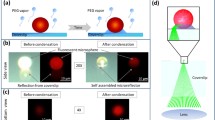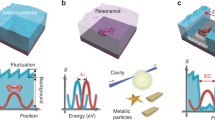Abstract
A significant amplification in the fluorescence signal is demonstrated when measured in metal (aluminum)-coated fluidic wells with volumes on the order of a nanoliter or smaller (nanowells). Photolithographic and wet etching procedures were used to fabricate these nanowells on glass substrates followed by vapor deposition of an aluminum layer on them. The fluorescence signal recorded in these structures was enhanced due to the reflection of the incident and emitted radiation by the metal layer as well as focusing of this light by the curvature of the well surface. While the first effect amplified the background signal in the entire assay chamber, the latter one produced signal hotspots around the edges and center of the nanowell. In this work, we were able to realize over a 20-fold enhancement in the fluorescence signal upon quantitating it at the central hotspot of an aluminum-coated circular nanowell with a depth and photo-patterned diameter of 30 µm and 38 µm, respectively. More interestingly, our experiments indicate that this enhancement factor may be further improved by optimizing the curvature of the nanowell surface to merge all the signal hotspots within a smaller detection zone. Finally, quantitative assays using horseradish peroxidase samples were performed on the reported signal enhancement platform to further demonstrate its utility for making sensitive analytical measurements.
Graphical Abstract







Similar content being viewed by others
Data Availability
The datasets generated during and/or analysed during the current study are available from the corresponding author on reasonable request.
References
Smith CL, Kricka L, Krull UJ (1995) The development of single molecule environmental sensors. Biomol Eng 105:33–37
Eggeling C, Fries JR, Brand L, Günther R, Seidel CAM (1998) Monitoring conformational dynamics of a single molecule by selective fluorescence spectroscopy. Proc Natl Acad Sci 95:1556–1561
Ishii Y, Yanagida T (2000) Single molecule detection in life sciences. Single Mol 1:5–16
Devadhasan JP, Kim S, An J (2011) Fish-on-a-chip: a sensitive detection microfluidic system for alzheimer’s disease. J Biomed Sci 18:33–44
Baker CA, Duong CT, Grimley A, Roper MG (2009) Recent advances in microfluidic detection systems. Bioanalysis 1:967–975
Wissberg S, Ronen M, Oren Z, Gerber D, Kalisky B (2020) Sensitive readout for microfluidic high-throughput applications using scanning SQUID microscopy. Sci Rep 10:1573–1580
Mogensen KB, El-Ali J, Wolff A, Kutter JP (2003) Integration of polymer waveguides for optical detection in microfabricated chemical analysis systems. Appl Opt 42:4072–4078
Salimi-Moosavi H, Jiang YT, Lester L, McKinnon G, Harrison DJ (2000) A multireflection cell for enhanced absorbance detection in microchip-based capillary electrophoresis devices. Electrophoresis 21:1291–1299
Macounová K, Cabrera CR, Yager P (2001) Concentration and separation of proteins in microfluidic channels on the basis of transverse IEF. Anal Chem 73:1627–1633
Wang YC, Stevens AL, Han J (2005) Million-fold preconcentration of proteins and peptides by nanofluidic filter. Anal Chem 77:4293–4299
Yanagisawa N, Dutta D (2012) Enhancement in the sensitivity of microfluidic enzyme-linked immunosorbent assays through analyte preconcentration. Anal Chem 84:7029–7036
Giri B, Dutta D (2014) Improvement in the sensitivity of microfluidic ELISA through field amplified stacking of the enzyme reaction product. Anal Chim Acta 810:32–38
Giri B, Pandey B, Neupane B, Ligler FS (2016) Signal amplification strategies for microfluidic immunoassays. TrAC - Trends Anal Chem 79:326–334
Pena J, McAllister SJ, Dutta D (2014) A glass microchip device for conducting serological survey of West Nile viral antibodies. Biomed Microdevices 16:737–743
Yanagisawa N, Mahmud S, Dutta D (2020) Absorbance detection in multireflection microfluidic channels using a commercial microplate reader system. Anal Chem 92:13050–13057
Bien DCS, Rainey PV, Mitchell SJM, Gamble HS (2003) Characterization of masking materials for deep glass micromachining. J Micromech Microeng 13:S34–S40
Yanagisawa N, Dutta D (2011) Kinetic ELISA in microfluidic channels. Biosensors 1:58–69
Kinde TF, Dutta D (2013) A microfluidic SPLITT device for fractionating low-molecular weight samples. Anal Chem 85:7167–7172
Kinde TF, Lopez TD, Dutta D (2015) Electrophoretic extraction of low molecular weight cationic analytes from sodium dodecyl sulfate containing sample matrices for their direct electrospray ionization mass spectrometry. Anal Chem 87:2702–2709
Kinde TF, Hess N, Dutta D (2020) Enhancement in MS-based peptide detection by microfluidic free-flow zone electrophoresis. Electrophoresis 41:545–553
Szekely L, Guttman A (2005) New advances in microchip fabrication for electrochromatography. Electrophoresis 26:4590–4594
Giri B, Peesara RR, Yanagisawa N, Dutta D (2015) Undergraduate laboratory module for implementing ELISA on the high performance microfluidic platform. J Chem Educ 92:728–732
Reyes DR, Iossifidis D, Auroux PA, Manz A (2002) Micro total analysis systems. 1. Introduction, theory, and technology. Anal Chem 74:2623–2636
Toh GM, Corcoran RC, Dutta D (2010) Sodium silicate based sol-gel structures for generating pressure-driven flow in microfluidic channels. J Chromatogr A 1217:5004–5011
Zhao Y, Huang WM, Purnawali H (2012) Advanced materials and engineering applications. Book Series: Appl Mech Mater 161:292–295
Lakowicz JR, Geddes CD, Gryczynski I, Malicka J, Gryczynski Z, Aslan K, Lukomska J, Matveeva E, Zhang J, Badugu R, Huang J (2004) Advances in surface-enhanced fluorescence. J Fluoresc 4:425–441
Sultangaziyev A, Bukasov R (2020) Review: Applications of surface-enhanced fluorescence (SEF) spectroscopy in bio-detection and biosensing. Sens Bio-Sens Res 30:100382
Yanagisawa N, Mecham JO, Corcoran RC, Dutta D (2011) Multiplex ELISA in a single microfluidic channel. Anal Bioanal Chem 401:1173–1181
Giri B, Liu Y, Nchocho FN, Corcoran RC, Dutta D (2018) Microfluidic ELISA employing an enzyme substrate and product species with similar detection properties. Analyst 143:989–998
Uddin MJ, Bhuiyan NH, Shim JS (2021) Fully integrated rapid microfluidic device translated from conventional 96-well ELISA kit. Sci Rep 11:1986
Ehrl BN, Liebherr RP, Gorris HH (2013) Single molecule kinetics of horseradish peroxidase exposed in large arrays of femtoliter-sized fused silica chambers. Analyst 138:4260–4265
Funding
This research work was supported by funds from the National Science Foundation and Wyoming INBRE program through grants CHE-1808507 and P20GM103432, respectively.
Author information
Authors and Affiliations
Corresponding author
Ethics declarations
Conflict of interest
The authors declare no competing interests.
Additional information
Publisher's note
Springer Nature remains neutral with regard to jurisdictional claims in published maps and institutional affiliations.
Supplementary Information
Below is the link to the electronic supplementary material.
Rights and permissions
Springer Nature or its licensor (e.g. a society or other partner) holds exclusive rights to this article under a publishing agreement with the author(s) or other rightsholder(s); author self-archiving of the accepted manuscript version of this article is solely governed by the terms of such publishing agreement and applicable law.
About this article
Cite this article
Mahmud, S., Dutta, D. Fluorescence signal amplification by optical reflection in metal-coated nanowells. Microchim Acta 189, 478 (2022). https://doi.org/10.1007/s00604-022-05577-y
Received:
Accepted:
Published:
DOI: https://doi.org/10.1007/s00604-022-05577-y




